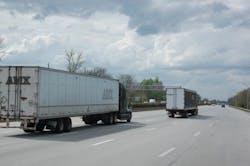There’s lots of talk in trucking these days about how “Big Data” is transforming the industry – and, as a result, how information technology (IT) may become as critical to motor carrier operations as trucks, drivers, and diesel fuel.
Now, a lot of truckers may rightly discount such talk as (of course) freight can be moved without IT, while it certainly cannot without trucks, drivers or diesel. Yet more effective parsing of information by motor carriers is what’s going to allow them to be more efficient and thus more profitable when moving freight in the future.
For example, take a look at the traffic management IT package IBM put together for the city of Dublin, Ireland two years ago – a system that’s ostensibly designed to help alleviate congestion choke points. Big data makes it possible, and I’m also pretty sure trucking operation experts can see how access to such detailed information could improve freight throughput and delivery times.
Lee Congdon, chief information officer (CIO) for Red Hat, Inc., noted recently that how companies use IT is changing rapidly, shifting from what he calls a “keep the lights on” strategy to one where IT is driving strategic initiatives like customer experience and service innovation.
“It is clear to me that the role of the CIO is changing as a result too, now playing an essential role in IT-driven business innovation,” Congdon (seen below) added. “It’s no surprise that businesses are being transformed by new technologies, especially those that bring more intelligence and mobility to their operations and products.”Red Hat calls companies that use IT in such “transformative” ways “Innovation Accelerators” as they are driving transformation by pursuing IT-enabled business innovation as a core strategy throughout their organization.
Recently, Red Hat conducted a study dubbed the Business Transformation and the CIO Role with the help of Harvard Business Review Analytic Services that polled 420 global business leaders and found that such “Innovation Accelerators” represent 32% of those surveyed and that they anticipate significant change over the next three years, particularly in how they engage with and learn about customers, as well as in their business models, products and services, and end user processes.
Specifically, “Innovation Accelerators” are more than twice as likely to invest in the creation of new applications compared to peers in companies where innovation is not a priority (72% vs. 34%) and are also more likely to focus on revenue generating opportunities with new customer experience strategies (71%), business model innovation (69%) and service innovation (68%).
By contrast, companies for which innovation is not a priority will focus more internally on the automation of business processes (70%), Red Hat’s survey found.
How does that apply to trucking? Well in a blog post yesterday I referenced a recent study compiled by Chris Ferrell, director of the Tompkins Supply Chain Consortium, regarding future transportation trends to keep an eye upon.
One of the trends Tompkins is watching closely is how internet-based e-commerce is creating an ever-growing expectation by customers to get exactly what they want whenever they want it. How does this affect transportation? In a world where most consumers’ expectations include “free shipping” in exchange for a minimum purchase and everyone’s prices can be compared with just a couple of mouse clicks, Tompkins’ Ferrell believes the ability for transportation professionals to minimize costs without sacrificing service will be paramount.
The biggest opportunity here may be the most difficult because it requires buy-in from the fulfillment side: right-sizing the boxes in which the merchandise is being shipped. Just as the combining of products into single-case orders is a money-saver, shipping dead air in overwrap that is much too large presents an enormous opportunity for companies for whom parcel shipping was once considered an afterthought.On top of this, Tompkins points to early estimates from the 2013 holiday season suggest that 33% to 40% of seasonal shopping was done online. The online numbers throughout the year are not nearly that high, but the decade-long trend of double digit growth, year-over-year shows no sign of stopping.
That suggests that the transportation industry’s innovation is about to be tested in final mile delivery, Ferrell stressed in his report, as more and more manufacturers are selling their products direct-to-consumer, which means more and more companies are looking for that “final mile” delivery service.
Thus why IT is going to be so critical, Red Hat emphasizes, for the way organizations engage with and understand their customers leads the list of areas that will be changed the most by IT-enabled innovation. Red Hat’s survey found that 55% of its survey respondents said such “interaction” will be changed significantly, with 20% saying it will be completely transformed (rating it a 10 on a scale of 1 to 10) by IT systems.
For Innovation Accelerators, the numbers are significantly higher: 70% say their approach to customer engagement and insight will be significantly changed, with 33% indicating it will be completely transformed.
Here are some other findings from Red Hat’s poll:
- Respondents believe IT-enabled innovation will change the way employees do their work, with 48% expecting it to be “significantly” changed while 15% say it will be “completely transformed.”
- More than half of survey respondents are planning to automate business processes (67%); execute customer experience strategies (66%); create new applications (60%); and innovate their services (57%) and business models (56%) via new IT-led efforts.
- Business intelligence/analytics and mobile technologies and apps lead the list of technologies that survey respondents expect to drive business innovation over the next three years, at 66% and 53%, respectively. These are followed by process automation (44%), collaboration tools (29), cloud computing (28%) and social media (24%).
- Apparently “Innovation Accelerator” organizations highly value cross-functional collaboration, with nearly half (48%) reporting that IT and the business typically engage together to identify innovation opportunities.
- While CIOs have a mandate to help drive this innovation, daily responsibilities of running IT and limited resources may be hindering their ability to do this. According Red Hat’s survey, while 57% believe the CIO should drive innovation and strategy, only 12% say their CIO actually does that.
- Red Hat’s poll also indicated that CIOs at “Innovation Accelerator” companies perform more strategic roles, developing and refining business strategy (26%), driving business innovation (30%), and identifying opportunities for competitive differentiation (26%).
It all adds up to a pretty dizzying pace of change where IT is concerned. Yet keeping up with that pace may be critical for trucking so it can keep ahead of potential shifts in freight strategy, driven in part by new and different customer expectations.


